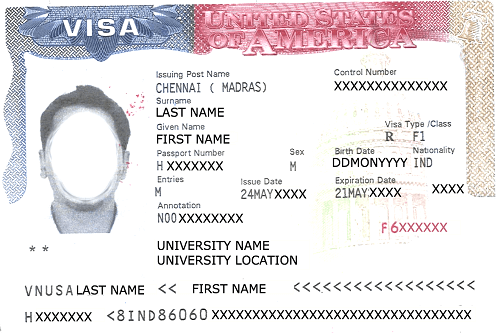Easy Way to Apply Student Visa for Usa From India
Second only to tourism, higher education in the US is the major reason millennials choose to fly to the United States. But before you can enter the country as a student, you need to know all about how to get a student visa for USA.
Table of Contents
- Visa: Your gateway to America
- About your student visa for USA
- Types of student visa for USA
- Breakdown of F-1 Visa Application Steps, Requirements, and Conditions
- Required F-1 visa interview documents-
- Attend your scheduled Visa Interview
- COVID-19 update
- Last-minute tips
- FAQ
Visa: Your gateway to America
International students can enter the US in the form of an F-1 student visa or the M-1 and J-1 visas. A majority of these students pursue a doctorate, master's, and bachelor's degree programs.
Visa application is an elaborate process and there is a lot that needs to be noted about how to get a student visa for the USA.
Currently, there are about 1.2 million international students in the US. A majority of them are on a US study visa (F-1 visa) typically awarded to foreigners pursuing college degrees.
In 2016 alone, the number of F-1 student visa's issued was 644,204 and the acceptance rate was a staggering 80%. This is great news for all of you planning to study in the US.
Despite some controversy around visa restrictions in recent years, the US remains one of the most appealing destinations for international studies.
Any students who plan to study in the USA need to be aware of the procedure to apply for a student visa in USA.
About your student visa for USA

Depending on where you are from, there may be certain special conditions to qualify for an American student visa.
- The usual process begins with an application to a University of your choice in the US and being admitted into it.
- This is where you get your I-20 form or Acceptance Letter.
- With advice and assistance from a dedicated expert like iSchoolConnect, the entire process from school selection, submission of documents, and payment of SEVIS fees, right through all the visa application steps can be made a lot more smoother and hassle-free.
Your I-20 form is an application requirement for F and M visa categories. Below are the three different types of student visa for USA
Types of student visa for USA
Before you start wondering how to get a student visa for USA, check which type of student visa you want to apply for:
- M-1 Visa: is issued to international students looking to attend a vocational school or non-academic program.
- J-1 Visa: issued to exchange students, interns, teachers, professional trainees, or seasonal workers in the private cultural sector.
- F-1 Visa: is the type of student visa for USA issued to foreign students pursuing an academic or English Language program. The validity period lasts until you complete your study program.
Our focus is going to be on the F-1 visa, the class generally required for full-time academic studies in the US.
Breakdown of F-1 Visa Application Steps, Requirements, and Conditions

Although your specific country or embassy may have additional application steps, requirements, and conditions, here is the general process-
- Apply and get admission into a SEVP (Student and Exchange Visitor Program) approved institution.
- Pay the SEVIS I-901 fee ($350) for enrollment into the SEVIS (Student and Exchange Visitor Information System).
- After this payment, your school provides you with an I-20 form which you will need to present to the consular officer at your F-1 visa interview. If you plan to travel and live with your children and/or spouse in the US, they will each need individual I-20 forms without needing enrollment into the SEVIS.
- Pay the non-refundable visa application fee and fulfill the application requirements of your specific embassy or consulate.
- The visa application is available online through which you could complete your application before printing the DS-160 form which you will take to your F-1 visa interview.
- Schedule and make preparations for your interview. Your interview is key to whether you will be awarded an F-1 student visa or not.
You can schedule the date but be aware of the variations in waiting periods for interview appointments which differ with regards to the visa category, season, or location.
So make your visa application early enough as you can get your US F-1 student visa up to 120 days before the starting date of your study program.
However, you will only be able to use your F-1 visa to travel to the United States within 30 days to the start of your course.
Required F-1 visa interview documents-
- Non-immigrant visa application form (Form DS-160)
- Standardized digital color passport photo taken recently
- A valid passport
- Receipt of visa application fee payment ($160)
- Certificate of Eligibility for Non-immigrant (F-1) Student Status (Form I-20)
- Documents proving adequate financial support during your stay in the US (Bank Statement)
- Diplomas, Transcripts, Certificates, and Degrees from your attended schools. Along with that, scores from standardized tests such as TOEFL, GMAT, SAT, GRE, etc.
- Documents that serve as proof of your intent to return, upon completing your program (for example; your asset documents or job offer letter valid after you complete the study).
Additional documents may be requested depending on your location or the specific program you have been admitted into.
Attend your scheduled Visa Interview

Your qualification for an F-1 student visa hinges on the short interview-
- During this, you will be asked a few personal questions related to your desire to study in the United States.
- You will have to carry all the appropriate documents we have listed above.
- Share your fingerprints for records and get your F-1 visa interview documents verified in advance.
- Your success in the interview depends upon how you can convince the Consular Officer of your qualification and intent to study.
- You will also have to give your passport so they can issue your visa with instructions on it.
COVID-19 update
When COVID-19 caused a worldwide shutdown in 2020, students planning to study abroad faced a great challenge – getting a visa.
Later, vaccines were invented and the situation slowly got better. Top education destinations began to open their doors for international students.
But then the second wave of COVID-19 hit, and things started to go downhill again.
According to the latest study abroad news, the US embassy is reevaluating its decisions. Watch the video below to learn more.
Last-minute tips
This entire visa application process is highly crucial for your dreams of studying abroad. And yet, it can be a grueling and exhausting process.
You have to work closely with your international adviser within the restrictions of your visa.
For instance, students only have 60 extra days after completing their study program in the US. After this, they either have to leave the country or get a transfer to another school or find a job. Also, extensions are possible, provided you follow the required conditions and procedures.
So if you get stuck or have any doubts, you can drop a comment, contact us or check out our website and the many other helpful blogs we have on the visa application process.
We'd be very happy to help!
Read next: Types of US Visas | Everything to know about the visa application!
/p>
FAQ
Q1. What is the application fee for a student visa?
Answer- The application fee for the student visa is $160. You must pay this fee and get the receipt, which you will need later for your interview documents. You might have to pay additional fees based on your country of origin and the US Embassy you are applying from.
Q2. Who can sponsor the F1 visa?
Answer-Parents and relatives can sponsor the F1 visa. In addition, education loans can also sponsor the visa.
Q3. How long is an F1 visa valid for?
Answer- Students on F-1 visas are allowed a60-day period of stay in the United States after their university program ends. Authorized exceptions for work, internships, or continued learning are available.
Source: https://ischoolconnect.com/blog/getting-usa-f1-student-visa/
0 Response to "Easy Way to Apply Student Visa for Usa From India"
Post a Comment